Samsung Fascinate Review: Verizon's Galaxy S Smartphone
by Brian Klug on October 5, 2010 12:01 AM EST- Posted in
- Smartphones
- Samsung
- Galaxy S
- Fascinate
- Mobile
Hardware Impressions and Analysis
The Fascinate feels unlike almost any other high-end Android device I've had the chance to review so far. Where other smartphones are predominantly metal and thus pack some considerable heft, the Fascinate is lightweight and just a tad plasticky. It's simultaneously amazing that a smartphone can feel so insubstantial, and just a bit unnerving.
The second thing that's striking about the Fascinate is that it's also incredibly thin. In fact, it's nearly as thin as the iPhone 4:

(Left to right) Motorola Droid 2, Samsung Fascinate, iPhone 4
By the numbers, the Fascinate is just 0.61 mm thicker than the iPhone 4. But it's also 10 grams lighter. You've got our usual comparison table to compare thicknesses on paper, but it's hard to really convey just how thin the Fascinate feels. The rest of the Galaxy S line - with the exception of the Epic - shares this same impressive waistline.
To that extent, whether you like or hate how the phone feels in your hand will depend on whether you gauge quality as a function of mass. If heavier and more substantial translates to better constructed for you, the Fascinate will undoubtedly feel a bit cheap. However, if you're all for lighter and thinner devices, the Fascinate is perfect - it's the kind of device you can forget is in your pocket despite having a 4 inch screen.
I mentioned that the phone feels somewhat plasticky to me - it's entirely because of the build material you're in contact with. The back cover itself is entirely smooth, glossy plastic. Likewise, the sides and edges of the Fascinate are glossy plastic. The unfortunate consequence of this choice is that - like the iPhone, it's prone to scratching almost immediately and showing fingerprints. Even living completely alone in my pocket for a week or two, the Fascinate's back is now visibly scratched under the right angle of illumination. I promise it isn't as noticeable as it looks here, but it's enough to occasionally shock when the light catches it the wrong way. It's eerily reminiscent of how prone to scratching the iPhone 3G and 3GS backs are.
There's a dark glossy checkerboard pattern on the back, but the actual surface itself is completely smooth. The Fascinate's back cover material is thus very similar in nature to the Vibrant.
Getting the cover off involves sticking your thumb in a small notch the bottom of the device and literally prying the whole thing off. There's a small raised bit for the speakerphone output on the rear of the device, and two notches for getting that audio out.
The camera and flash area protrudes through the back cover and doesn't come off. This is nice, as on devices like the Nexus One, there's a second plastic layer between the camera integrated into the back cover where fingerprints and gunk collect, adding to camera glare.
Under the cover, the Fascinate is pretty spartan. There's the click-to-eject type microSD port, and down below is a 5.55 Whr Li-ion battery.
On the left are the volume rocker button and a port for the secondary microphone for noise cancellation. You can follow that port inside to a small chamber where the microphone is. There aren't any markers on the volume rocker - then again up and down are pretty obvious. The volume rocker is also a multipurpose zoom control in the browser and camera application, which is probably part of why it's left unmarked.
The right side is pretty boring, sporting the power button (which is thankfully marked) about 2/3rds up the side of the device. Location of the power button is perfect for your thumb when held in the right hand, or index finger when held in the left hand.
Things are interesting up top. There's the standard 1/8", 3.5 mm audio jack for headphones, a "Digital by Qualcomm" sticker, and the microUSB cover hiding the port underneath. The cover itself slides back and forth and has two detents that hold the cover open or closed. There's a groove you can get your nail into to slide the mechanism.
Putting the microUSB port on the top may seem like a strange choice - something I even pointed out in the Nokia N900 review - but it makes some sense. For one, it gets the cable out of the way when you're using the device while charging. Second, it also means you can dump the phone right side up into a cupholder in the car while on the go. For me at least, having the charger somewhere other than the side makes using the device while charging or taking screenshots a heck of a lot less of a balancing act.
It's a choice that will probably seem very strange to people at first, but definitely doesn't impede using the Fascinate plugged in.
The Fascinate's hardware for me is ultimately a mixed bag. I love the fact that it's thin and light, but it feels so insubstantial in my hands that sometimes I forget it's a tier-1 smartphone. That isn't to say that the Fascinate feels cheap or has bad build quality - it doesn't - it just doesn't really inspire gobs of confidence the first time you pick it up. There's no rattling when the Fascinate vibrates, something I find indicative of build quality, and there's no doubt about the rigidity of the structure. It just has a weird feel in an open palm.
I really like that the Fascinate is thin and lightweight - I just don't like that the back feels the way it does.
The most obvious physical comparisons to the Fascinate's 4" form factor are the Droid X and the EVO 4G. I don't have the Droid X anymore and thus couldn't grab a shot, but I do have Anand's EVO 4G. The two are almost the same size wise, with the Droid X being just a few millimeters taller. I tossed in the iPhone 4 for good measure:
125 mm (4.92")
| Physical Comparison | |||||||||
| Apple iPhone 4 | HTC EVO 4G | Motorola Droid X | Motorola Droid 2 | Samsung Galaxy S Fascinate | |||||
| Height | 115.2 mm (4.5") | 121.9 mm (4.8") | 127.5 mm (5.02") | 116.3 mm (4.6") | 125 mm (4.92") | ||||
| Width | 58.6 mm (2.31") | 66.0 mm (2.6") | 66.5 mm (2.62") | 60.5 mm (2.4") | 63.5 mm (2.5") | ||||
| Depth | 9.3 mm ( 0.37") | 12.7 mm (0.5") | 9.9 mm (0.39") | 13.7 mm (0.54") | 9.91 mm (0.39") | ||||
| Weight | 137 g (4.8 oz) | 170 g (6.0 oz) | 155 g (5.47 oz) | 169 g (5.9 oz) | 117 grams (4.16 oz) | ||||
| CPU | Apple A4 @ ~800MHz | Qualcomm Scorpion @ 1GHz | TI OMAP 3630 @ 1GHz | Texas Instruments OMAP 3630 @ 1 GHz | 1 GHz Samsung Hummingbird | ||||
| GPU | PowerVR SGX 535 | Adreno 200 | PowerVR SGX 530 | PowerVR SGX 530 | PowerVR SGX 540 | ||||
| RAM | 512MB LPDDR1 (?) | 512MB LPDDR1 | 512MB LPDDR1 | 512 MB LPDDR1 | 512 MB LPDDR1 | ||||
| NAND | 16GB or 32GB integrated | 8GB micro SD | 8GB micro SD | 8 GB integrated, preinstalled 8 GB microSD | 2 GB, 16 GB microSD (Class 2) | ||||
| Camera | 5MP with LED Flash + Front Facing Camera | 8MP with dual LED Flash + Front Facing Camera | 8MP with dual LED Flash | 5 MP with dual LED flash and autofocus | 5 MP with auto focus and LED flash | ||||
| Screen | 3.5" 640 x 960 LED backlit LCD | 4.3" 480 x 800 | 4.3" 480 x 854 | 3.7" 854 x 480 | Super AMOLED 800 x 480 | ||||
| Battery | Integrated 5.254Whr | Removable 5.5Whr | Removable 5.698 Whr | Removable 5.2 Whr | Removable 5.55 Whr | ||||
Product packaging is an increasingly important aspect of smartphone presentation. Where the Motorola Droids thus far have been packaged in small and relatively basic boxes for optimal packing density, the Fascinate has more lavish, larger packaging. Inside the box you get phone on top, then below it are manuals, power adapter, and USB cables. Pretty standard fare, but still nicer than I've seen other packaging.


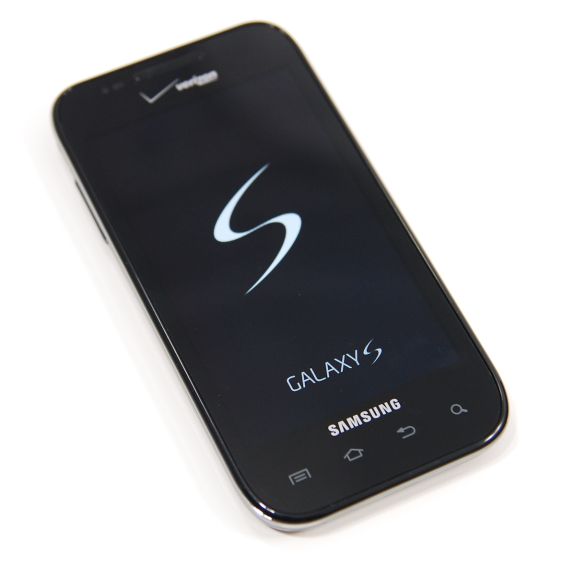
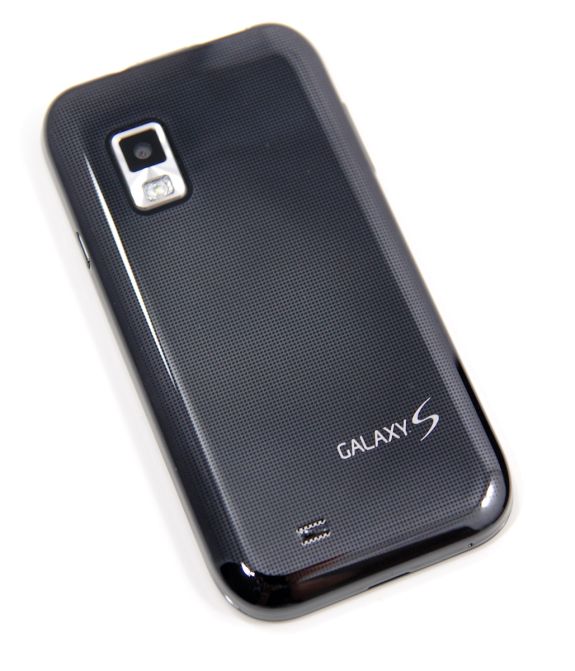
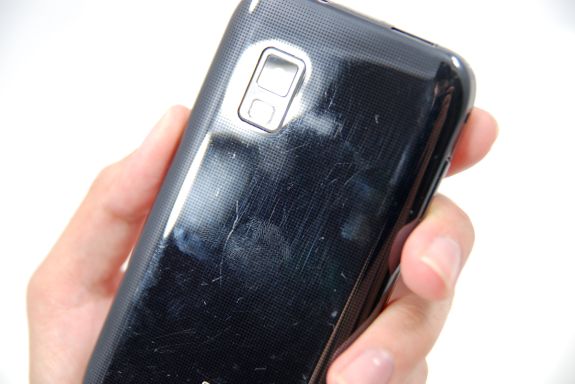

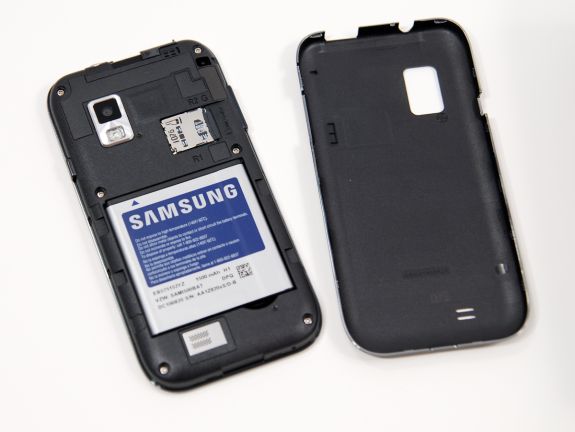




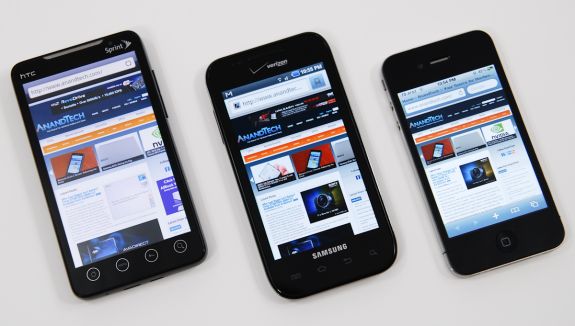
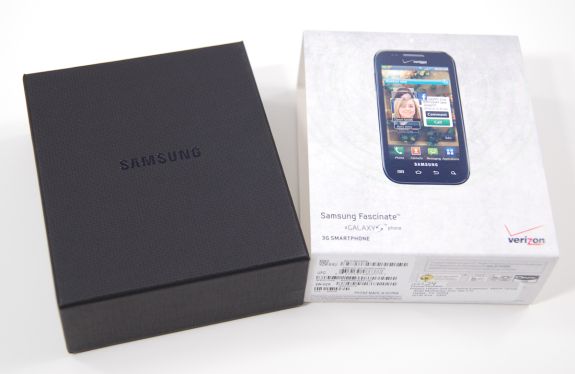








73 Comments
View All Comments
metafor - Tuesday, October 5, 2010 - link
That seems to be a common misconception. Just think about it, the processor is somewhere around ~500mW doing an intensive task. Compare that to an RF radio chip that eats 2W or so while communicating to a 3G cell tower. Or the 2-3W display....The App Processor is a small percentage of overall power draw.
strikeback03 - Tuesday, October 5, 2010 - link
Agreed, checking the power usage utility on Android it isn't uncommon to see the screen drawing the vast majority of the power. Which AMOLED has the potential to help with if there were a way to format websites to be more friendly to it (i.e. no white backgrounds).metafor - Tuesday, October 5, 2010 - link
I'm personally banking on either Pixel Qi or Mirasol improving to the point where they can take over being the displays used. The power savings would warrant any apparent difference in image quality as long as it's "good enough".JimmiG - Wednesday, October 6, 2010 - link
"Just think about it, the processor is somewhere around ~500mW doing an intensive task. Compare that to an RF radio chip that eats 2W or so while communicating to a 3G cell tower. Or the 2-3W display...."I guess you're right. I can play games and watch video on my HTC Desire without using much battery, but 3G browsing absolutely kills battery life. My daily routine involves heavy 3G web browsing on the 1-hour commute to school by train, then the phone spends most of the day in standby, then another hour of heavy usage on the way home in the afternoon. This is enough to run the battery down to ~10% by the time I get home, if I'm lucky enough to have it last the whole day.
But then, how does the iPhone4 manage nearly 7 hours of 3G browsing? Does it use a different radio chip, is it the network, or what?
metafor - Wednesday, October 6, 2010 - link
RF chips don't really vary that much. I would take a guess that it's good software management. What you don't realize is that most of the time you're browsing, you're not actually loading data. You have a burst of data as the website loads, but then it stops.I've noticed on my iPhone that periods of inactivity -- while I'm reading a webpage -- would cause the signal bar to drop a bit. It would go back up once I clicked on a link.
I suspect the software is putting the RF chip in a low-power mode more aggressively than HTC equivalents.
A lot of people discount it but software throttling is the single-most effective way of reducing power consumption.
ssj4Gogeta - Tuesday, October 5, 2010 - link
Is there any chance you'll do an I9000 review? It's the European/Asian version of the Galaxy S. It comes unlocked, doesn't have loads of crap preinstalled, and trades the LED flash for a front VGA cam. It also doesn't have a search button, but you can long-press the menu button to search.Also, please consider trying the voodoo lag fix in your future Galaxy S reviews.
http://project-voodoo.org/
It basically changes the system partition file system from RFS to EXT4, which makes the phone noticeably faster and smoother (no stalling while installing apps, no stuttering..)
8steve8 - Tuesday, October 5, 2010 - link
i personally have an international galaxy s with beta froyo rom (JPK), with lagfix, these are the numbers i get:Rightware BrowserMark:
35345 : my galaxy s 2.2
29018 : fascinate 2.1
sunspider:
07375.8ms : my galaxy s 2.2
15835.0ms : fascinate 2.1
linpack:
14.399 MFLOPS : my galaxy s 2.2
08.157 MFLOPS : fascinate 2.1
NeoCore Benchmark:
55.6FPS : my galaxy s 2.2
55.6FPS : fascinate 2.1
quadrant:
2000ish : my galaxy s 2.2 w/lagfix
0800ish with my galaxy s 2.1 stock
the phone ships with a terrible filesystem setup, causes severe lag over time... as shown in the quadrant score which does some IO stuff... this is fixable with root and a lagfix app...
and gps works about as good as my nexus one
(although in 2.1 builds of the firmware GPS was terrible)
this has been said by everyone, but the 4" SAMOLED displays on these things are sick... makes a nexus one display look really dated, and although props to the iphone for finally getting hi-res, 3.5" just seems comparably too small.
annoying it shipped so broken, but once dealt with, a beautiful device and over-all experience
ssj4Gogeta - Wednesday, October 6, 2010 - link
You don't even require root for voodoo lagfix. It comes in an update.zip and changes the filesystem to ext4.webmastir - Tuesday, October 5, 2010 - link
fantastic review. this is why i love this site! great job & great info.Shadowmaster625 - Tuesday, October 5, 2010 - link
If you can forget that a $500+ piece of hardware is in your pocket, then you need to be... outsourced.